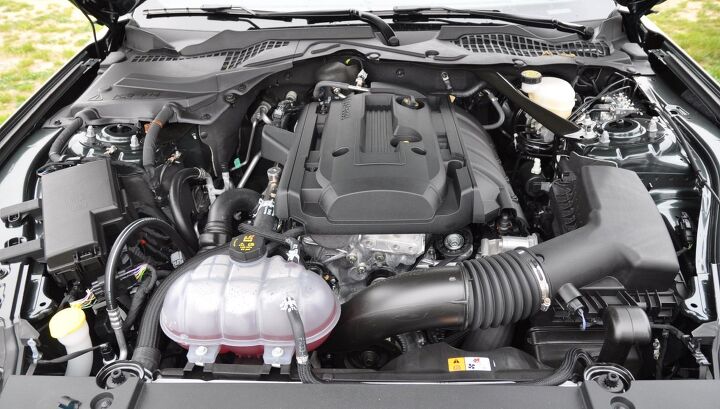Ford Wants Far Less Metal in Its Cylinder Heads

Iron or aluminum? For cylinder head construction, that’s the basic menu we’ve long grown used to. There’s advantages and drawbacks to both. Aluminum is lighter, but more prone to warping. Iron is stronger but heavier, with low thermal conductivity. Both materials are prone to the ups and downs of the commodities market, frustrating beancounters working at automakers everywhere.
In a U.S. patent application filed in October and published today, Ford Motor Company’s global tech division proposes something new: a cylinder head containing a barest minimum of metal. Called the Hybrid Composite Cylinder Head, most of the component’s bulk is made up of polymer composite, not aluminum or iron.
Ford Global Technologies LLC points out that partial ceramic or fiber-reinforced ceramic composites have been proposed in cylinder head construction before, but both suffer from major drawbacks in withstanding high heat and pressure. Nor can ceramic be molded around a metal skeleton. With its mind on efficiency (soaring aluminum prices hammered Ford’s bottom line in 2017), the automaker took a different approach.
The proposed head features an internal metal structure surrounded by a polymer composite structure, one which may be fiber reinforced. The metal structure, made of cast iron, could include upper combustion chambers, combustion chamber inserts, fire deck, engine coolant ports, and oil drain ports. Meanwhile, the polyment structure gets some holes of its own. The patent claims the surrounding structure could include intake or exhaust oil feeds for a hydraulic lash adjuster, plus spark plug and direct injection pockets.
Any number of resins, or a combination thereof, could make up the polymer composite structure, with silicone or some kind of fiber being another possible ingredient. Ford’s clearly not ruling much out in this patent.
What the automaker hopes to achieve is a cylinder head that’s light, durable, corrosion-resistant, and far less costly to build than existing components. An added benefit from the reduced weight would be a tiny increase in fuel efficiency. The patent states that the head could find a home on a direct-injected gasoline engine or a port-injected gas or diesel engine.
As lightweight, high-strength carbon fiber slowly begins finding its way into cars, it’s not surprising to see Ford look at metal alternatives for its engine components. Two years ago, the automaker showed off a 1.0-liter EcoBoost engine at the Detroit auto show that made use of injection-molded carbon fiber for a number of parts, including the cylinder head. The mill’s weight fell nearly 16 percent compared to a stock motor.
Last year, Ford and Magna teamed up to develop a carbon fiber-reinforced composite subframe. This key piece of architecture weighed 34 percent less than a conventional subframe, employing far fewer parts.
H/T to Bozi Tatarevic!
[Image: United States Patent and Trademark Office]

More by Steph Willems
Latest Car Reviews
Read moreLatest Product Reviews
Read moreRecent Comments
- Theflyersfan The wheel and tire combo is tragic and the "M Stripe" has to go, but overall, this one is a keeper. Provided the mileage isn't 300,000 and the service records don't read like a horror novel, this could be one of the last (almost) unmodified E34s out there that isn't rotting in a barn. I can see this ad being taken down quickly due to someone taking the chance. Recently had some good finds here. Which means Monday, we'll see a 1999 Honda Civic with falling off body mods from Pep Boys, a rusted fart can, Honda Rot with bad paint, 400,000 miles, and a biohazard interior, all for the unrealistic price of $10,000.
- Theflyersfan Expect a press report about an expansion of VW's Mexican plant any day now. I'm all for worker's rights to get the best (and fair) wages and benefits possible, but didn't VW, and for that matter many of the Asian and European carmaker plants in the south, already have as good of, if not better wages already? This can drive a wedge in those plants and this might be a case of be careful what you wish for.
- Jkross22 When I think about products that I buy that are of the highest quality or are of great value, I have no idea if they are made as a whole or in parts by unionized employees. As a customer, that's really all I care about. When I think about services I receive from unionized and non-unionized employees, it varies from C- to F levels of service. Will unionizing make the cars better or worse?
- Namesakeone I think it's the age old conundrum: Every company (or industry) wants every other one to pay its workers well; well-paid workers make great customers. But nobody wants to pay their own workers well; that would eat into profits. So instead of what Henry Ford (the first) did over a century ago, we will have a lot of companies copying Nike in the 1980s: third-world employees (with a few highly-paid celebrity athlete endorsers) selling overpriced products to upper-middle-class Americans (with a few urban street youths willing to literally kill for that product), until there are no more upper-middle-class Americans left.
- ToolGuy I was challenged by Tim's incisive opinion, but thankfully Jeff's multiple vanilla truisms have set me straight. Or something. 😉



































Comments
Join the conversation
What could possible go wrong?
The Brits wanted to make an aircraft carrier out of ice and sawdust during WWII. Ford could use that technology to shore up those aluminum beds.